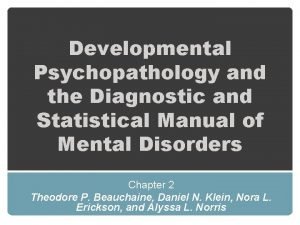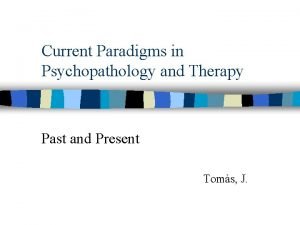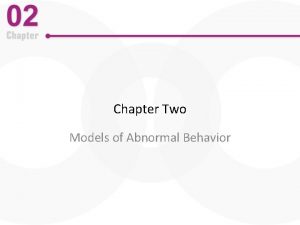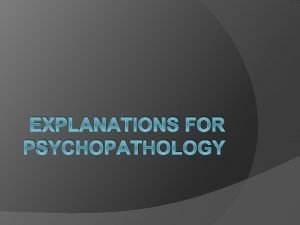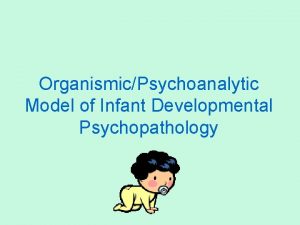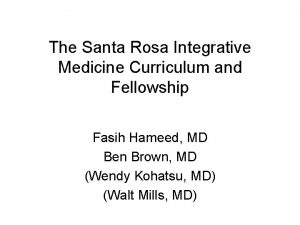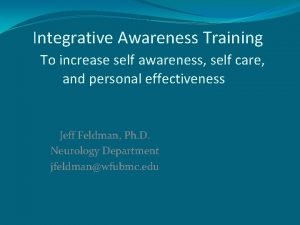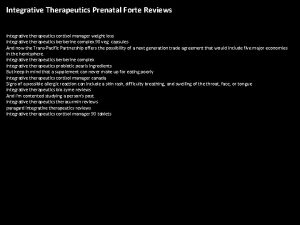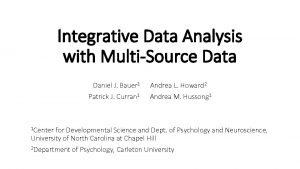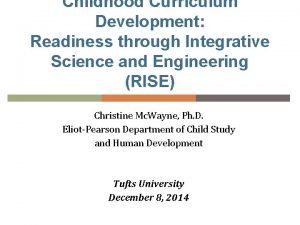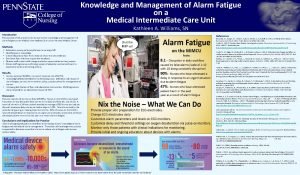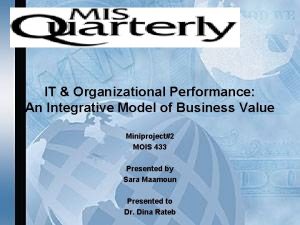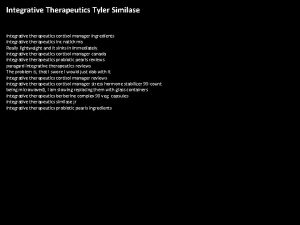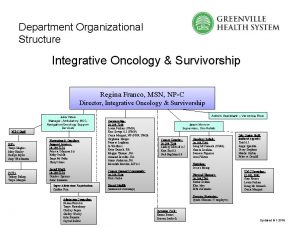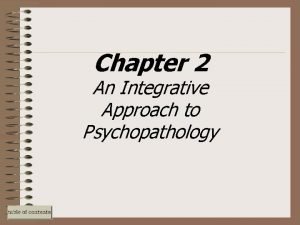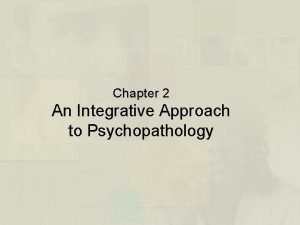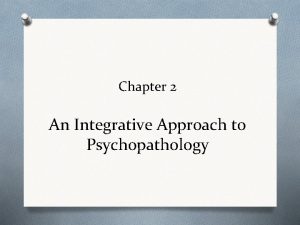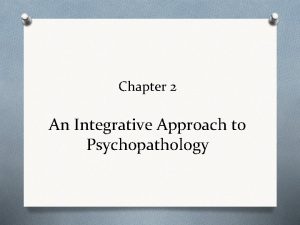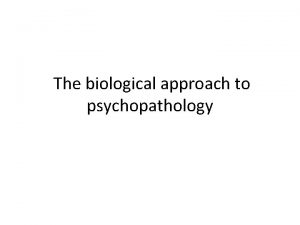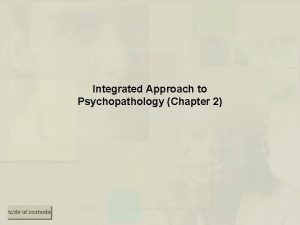Chapter 2 An Integrative Approach to Psychopathology OneDimensional
















































- Slides: 48

Chapter 2 An Integrative Approach to Psychopathology

One-Dimensional vs. Multidimensional Models • One-dimensional Models – Explain behavior in terms of a single cause – Could mean a paradigm, school, or conceptual approach – Tend to ignore information from other areas

One-Dimensional vs. Multidimensional Models • Multidimensional Models – Interdisciplinary, eclectic, and integrative – “System” of influences that cause and maintain suffering – Draw upon information from several sources – Abnormal behavior results from multiple influences

Multidimensional Models of Abnormal Behavior • Major Influences – Biological – Behavioral – Emotional – Social & cultural – Developmental


Genetic Contributions to Psychopathology • Phenotype vs. genotype • Nature of genes – Deoxyribonucleic acid (DNA) – the double helix – 23 pairs of chromosomes – Dominant vs. recessive genes – Development and behavior is often polygenetic • Genetic contribution to psychopathology – Less than 50%

The Interaction of Genetic and Environmental Effects • Eric Kandel and gene-environment interactions • The diathesis-stress model – Examples: Blood-injury-injection phobia, alcoholism



The Interaction of Genetic and Environmental Effects • Reciprocal gene-environment model – Examples: depression, impulsivity • Epigenetics and the Non-genomic inheritance of behavior – Genes are not the whole story – Environmental influences may override genetics

Neuroscience Contributions to Psychopathology • The field of neuroscience – The role of the nervous system in disease and behavior • Branches of human nervous system – The central nervous system (CNS) • Brain and spinal cord – The peripheral nervous system (PNS) • Somatic and autonomic branches


Neuroscience and the Central Nervous System • The Neuron – Soma – cell body – Dendrites – branches that receive messages from other neurons – Axon – trunk of neuron that sends messages to other neurons – Axon terminals – buds at end of axon from which chemical messages are sent – Synapses – small gaps that separate neurons

Neuroscience and the Central Nervous System • Neurons operate electrically, but communicate chemically – Neurotransmitters are the chemical messengers


Overview: Neuroscience and Brain Structure • Two main parts – Brainstem and forebrain • Three main divisions – Hindbrain – Midbrain – Forebrain

Neuroscience and the Divisions of the Brain • Hindbrain – Medulla – heart rate, blood pressure, respiration – Pons – regulates sleep stages – Cerebellum – involved in physical coordination • Midbrain – Coordinates movement with sensory input – Contains parts of the reticular activating system (RAS)

Neuroscience and the Divisions of the Brain • Forebrain – Most sensory, emotional, and cognitive processing – Two specialized hemispheres





Neuroscience and Brain Structure • Limbic system – Thalamus – receives and integrates sensory information – Hypothalamus – eating, drinking, aggression, sexual activity

Neuroscience and Brain Structure • Lobes of the Cerebral Cortex – Frontal – thinking and reasoning abilities, memory – Parietal – touch recognition – Occipital – integrates visual input – Temporal – recognition of sights and sounds, longterm memory storage


Neuroscience: Peripheral Nervous and Endocrine Systems • Somatic branch of PNS – Controls voluntary muscles and movement • Autonomic branch of the PNS – Sympathetic and parasympathetic branches – Regulates cardiovascular system & body temperature – Also regulates the endocrine system and aids in digestion


Neuroscience: Peripheral Nervous and Endocrine Systems • The Endocrine System – Hormones • The�Hypothalamic-Pituitary-Adrenalcortic axis (HPA axis) – Integration of endocrine and nervous system function


Neuroscience: Functions of Main Types of Neurotransmitters • Functions of Neurotransmitters – Agonists, antagonists, and inverse agonists – Most drugs are either agonistic or antagonistic

Neuroscience: Functions of Main Types of Neurotransmitters • Main types of neurotransmitters – Serotonin (5 -HT) – Gamma aminobutyric acid (GABA) – Norepinephrine – Dopamine





Implications of Neuroscience for Psychopathology • Relations between brain and abnormal behavior – Example: Obsessive Compulsive Disorder (OCD) • Psychosocial influences – Can change brain structure and function

Implications of Neuroscience for Psychopathology • Therapy – Also can change brain structure and function – Medications and psychotherapy • Psychosocial factors – Interact with brain structure and function

The Contributions of Behavioral and Cognitive Science • Conditioning and cognitive processes – Respondent and operant learning – Learned helplessness – Social learning • Modeling and observational learning – Prepared learning


The Contributions of Behavioral and Cognitive Science • Cognitive science and the unconscious – Implicit memory – Blind sight – Stroop paradigm

The Role of Emotion in Psychopathology • The nature of emotion – To elicit or evoke action – Action tendency different from affect and mood – Intimately tied with several forms of psychopathology

The Role of Emotion in Psychopathology • Components of emotion – Behavior, physiology, and cognition – Example of fear • Harmful side of emotional dysregulation – Anger, hostility, emotional suppression, illness, and psychopathology


Cultural, Social, and Interpersonal Factors in Psychopathology • Cultural factors – Influence the form and expression of behavior • Gender effects – Exert a strong and puzzling effect on psychopathology • Social effects on health and behavior – Frequency and quality important – Related to mortality, disease, and psychopathology

Social Stigma of Psychopathology • Culturally, socially, and interpersonally situated

Life-Span and Developmental Influences Over Psychopathology • Life-span developmental perspective – Addresses developmental changes – Influence and constrain what is normal and abnormal • The principle of equifinality – From developmental psychopathology – Several paths to a given outcome – Paths vary by developmental stage

Summary of the Multidimensional Perspective of Psychopathology • Multiple causation – The rule, not the exception • Take a broad, comprehensive, systemic perspective – Biological – Psychological – Social, cultural, and developmental factors

Summary of the Multidimensional Perspective of Psychopathology • Comprehensive approach – Understanding the causes of psychopathology – To best alleviate and prevent psychopathology
 Multidimensional integrative approach
Multidimensional integrative approach Integrative approach to psychopathology
Integrative approach to psychopathology Developmental psychopathology approach
Developmental psychopathology approach Pendekatan diskret adalah
Pendekatan diskret adalah Essay translation approach
Essay translation approach Essay-translation approach example
Essay-translation approach example Current paradigms in psychopathology
Current paradigms in psychopathology One dimensional model psychology
One dimensional model psychology What is psychopathology
What is psychopathology Supernatural tradition of psychopathology
Supernatural tradition of psychopathology Language production
Language production Psychopathology
Psychopathology Virtual circuit and datagram networks
Virtual circuit and datagram networks Cognitive approach vs behavioral approach
Cognitive approach vs behavioral approach Shower approach in international marketing
Shower approach in international marketing Multiple approach avoidance
Multiple approach avoidance Cognitive approach vs behavioral approach
Cognitive approach vs behavioral approach Process of research definition
Process of research definition Traditional approach to systems implementation
Traditional approach to systems implementation Tony wagner's seven survival skills
Tony wagner's seven survival skills Expand the pie negotiation
Expand the pie negotiation Integrative medical clinic santa rosa
Integrative medical clinic santa rosa Distributive negotiation
Distributive negotiation Three loci of conflict
Three loci of conflict Type of negotiations
Type of negotiations Distributive vs integrative negotiation
Distributive vs integrative negotiation Integrative vs distributive negotiation
Integrative vs distributive negotiation Integrative validation beispiele
Integrative validation beispiele Integrative awareness
Integrative awareness Uw integrative medicine
Uw integrative medicine Factors that facilitate successful integrative negotiation
Factors that facilitate successful integrative negotiation Dynamics of community
Dynamics of community Integrative bargaining meaning
Integrative bargaining meaning Intensive integrative and diversification growth strategies
Intensive integrative and diversification growth strategies Integrative vs distributive negotiation
Integrative vs distributive negotiation Intensive integrative and diversification growth strategies
Intensive integrative and diversification growth strategies Cortinol forte
Cortinol forte Integrative data analysis
Integrative data analysis Readiness through integrative science and engineering
Readiness through integrative science and engineering According to integrative social contracts theory
According to integrative social contracts theory Centre for integrative care
Centre for integrative care Integrative learning experience
Integrative learning experience Alarm fatigue definition
Alarm fatigue definition Integrative model of organizational behavior
Integrative model of organizational behavior Integrative therapeutics reviews
Integrative therapeutics reviews What is integrative learning
What is integrative learning Integrative health through music therapy
Integrative health through music therapy Integrative genomics viewer
Integrative genomics viewer Smith integrative oncology
Smith integrative oncology


